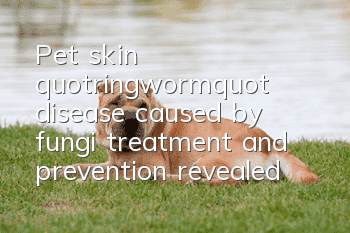Pet skin "ringworm" disease caused by fungi, treatment and prevention revealed!

Canine dermatophyte skin diseases are various skin diseases caused by dermatophytes invading the dog's skin, coat and keratin tissue of toes and claws. This disease is a zoonotic infectious disease, collectively referred to as "ringworm" by humans and doctors, and occurs all over the world.
1. The causes of canine fungal skin diseases:
1. The occurrence of skin mycosis in dogs has a certain relationship with climate, age and physical constitution. For example, the incidence rate is higher in hot and humid climates, and young animals are more susceptible than adult animals. Those with malnutrition and weak constitution are more susceptible than those with strong nutritional constitution.
2. In clinical practice, when the long-term application of large-dose stimulation causes the dog's resistance to decrease, it is also susceptible to the disease.
3. Pathogens According to clinical statistics, 5 kinds of molds have been found to cause skin mycosis in dogs. They are: Microsporum canis, Microsporum gypseum, Trichophyton mentagrophytes, Microsporum audouinii and Microsporum mutans. spores. Among them, Microsporum canis is the most common, followed by Microsporum gypseum, Trichophyton mentagrophytes and Microsporum audouinii. Microsporum proteus is only found in a few countries, such as Australia, and its incidence is low.
2. Clinical symptoms of canine fungal skin diseases:
1. Microsporum canis:
Found all over the world, more than 70% of canine ringworm cases are caused by it. A variety of animals and people can be infected. The main lesions are small round-like scabs (ringworm) formed on the skin surface. This kind of localized scab skin lesions can appear on any part of the dog, but the ears, face, neck and tail are the most common. This type of lesions, which are mainly skin scabs, are often not accompanied by hair loss. When there are not many lesions, especially when they occur in long-haired dogs, they are often not discovered. Microsporum canis mainly causes tinea capitis in humans.
2. Microsporum gypsum:
Living in soil all over the world, it can cause skin mycosis in dogs and other animals and humans. The onset of this disease is rapid and the damage is severe. The site of occurrence is similar to that of Microsporum. In addition to round pimples, it sometimes causes large-area skin lesions. The coat of the lesion falls off, and dandruff and scabs appear. When secondary bacterial infection occurs, exudative suppuration occurs locally. It can last for months or even years after it becomes chronic.
3. Microsporum auduanii and Trichophyton mentagrophytes:
Canine skin mycosis caused by these two bacteria is rare. These two molds can also infect people. The former mainly causes tinea capitis in children, and the latter is the main pathogen of athlete's foot in the United States. Dogs usually become infected through contact with sick people.
- What are the symptoms of allergies in dogs?
- Do all pugs have body odor?
- How should dogs be cared for in autumn? Pay attention to these 3 points when caring for your dog in autumn!
- Before getting a dog, learn how to choose a dog that suits you
- Don’t give these 15 foods to your dog
- What causes dogs to become infected with scabies mites?
- What should I do if my dog gets stuck eating?
- St. Bernard dog appearance characteristics and feeding methods
- How to deal with ear mites in Bichon Frize
- The most difficult stage to raise a golden retriever



